Change Management Analysis: BSSG Procurement Restructuring Report
VerifiedAdded on 2022/11/13
|29
|7445
|246
Report
AI Summary
This report focuses on organizational change management, specifically analyzing a case study involving BSSG, a company experiencing rapid growth and facing challenges in its procurement and sourcing processes. The report explores the forces driving organizational change, including market competition and technological advancements, and identifies the challenges BSSG faces in delivering high-quality projects. It delves into the concept of organizational change, outlining various types and the steps involved in effective change management. The report assesses BSSG's plan to restructure its procurement department, proposing strategies to improve efficiency and adapt to the changing business environment. It discusses the importance of communication, the role of leaders in managing change, and the significance of adapting to both internal and external forces. The report emphasizes the need for BSSG to transition from a tactical to a strategic procurement function to meet client demands and maintain a competitive edge. The analysis includes external forces like technology and market conditions, and internal forces such as human resource problems. Overall, the report provides a comprehensive overview of change management principles and their application to the BSSG case.
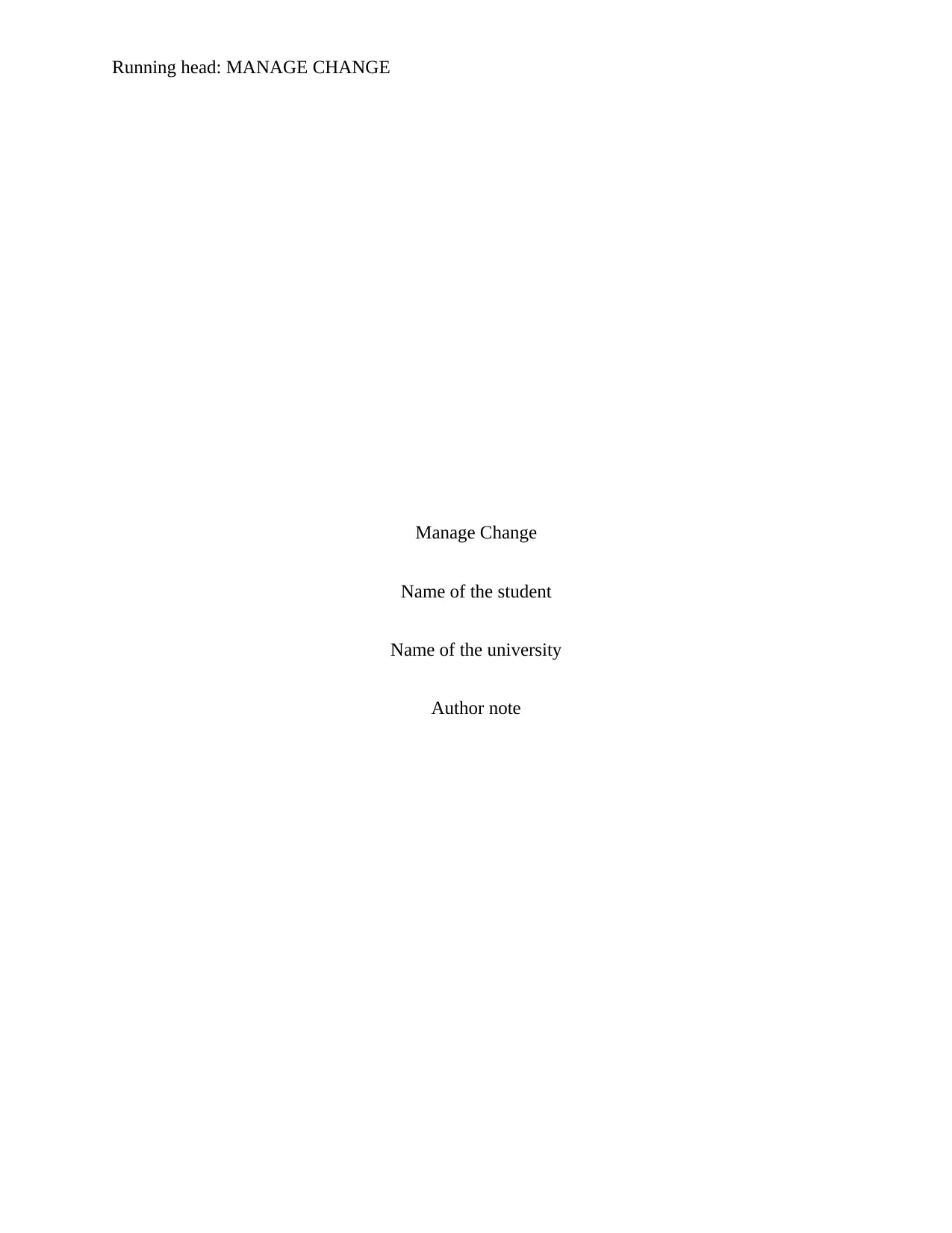
Running head: MANAGE CHANGE
Manage Change
Name of the student
Name of the university
Author note
Manage Change
Name of the student
Name of the university
Author note
Paraphrase This Document
Need a fresh take? Get an instant paraphrase of this document with our AI Paraphraser
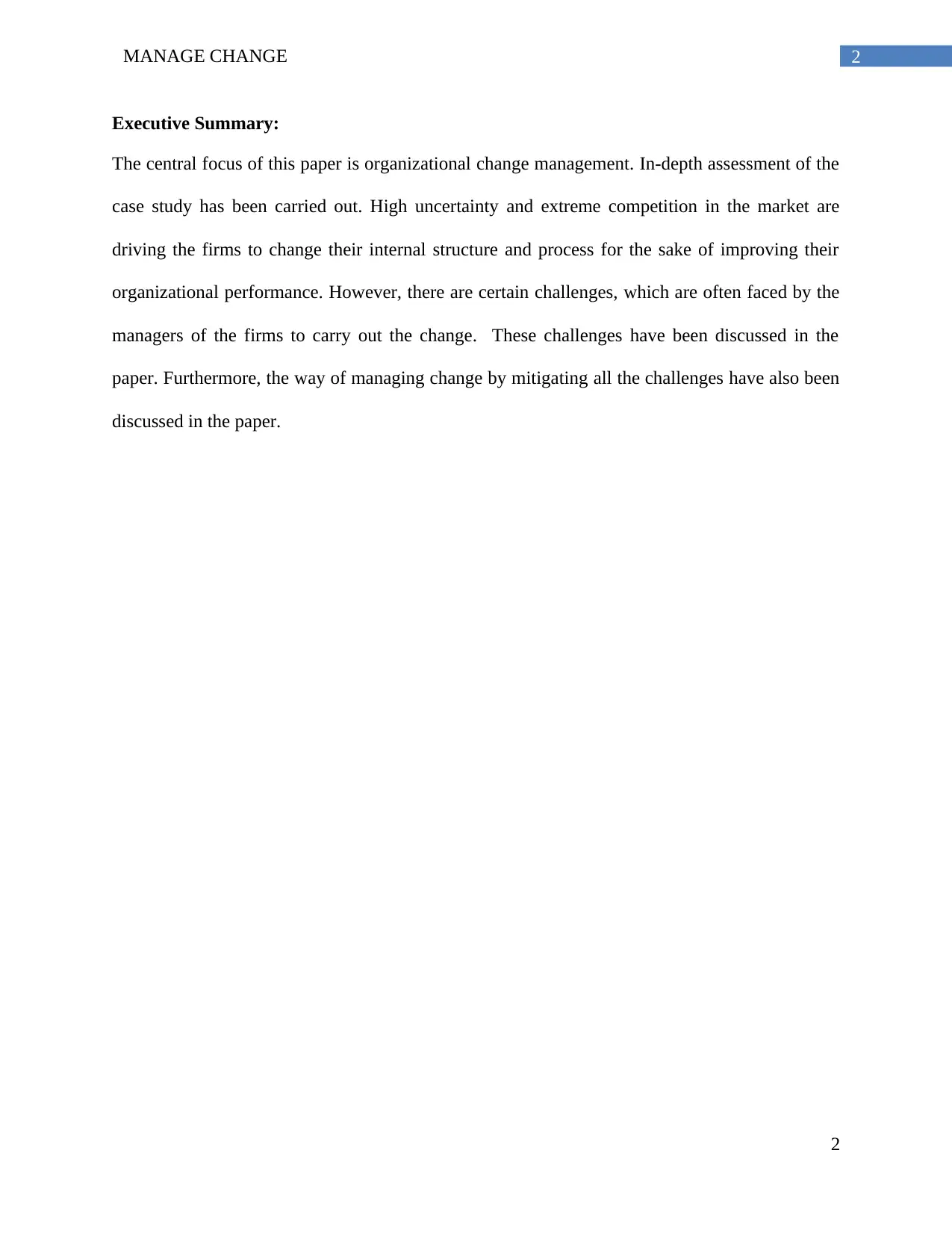
2MANAGE CHANGE
Executive Summary:
The central focus of this paper is organizational change management. In-depth assessment of the
case study has been carried out. High uncertainty and extreme competition in the market are
driving the firms to change their internal structure and process for the sake of improving their
organizational performance. However, there are certain challenges, which are often faced by the
managers of the firms to carry out the change. These challenges have been discussed in the
paper. Furthermore, the way of managing change by mitigating all the challenges have also been
discussed in the paper.
2
Executive Summary:
The central focus of this paper is organizational change management. In-depth assessment of the
case study has been carried out. High uncertainty and extreme competition in the market are
driving the firms to change their internal structure and process for the sake of improving their
organizational performance. However, there are certain challenges, which are often faced by the
managers of the firms to carry out the change. These challenges have been discussed in the
paper. Furthermore, the way of managing change by mitigating all the challenges have also been
discussed in the paper.
2
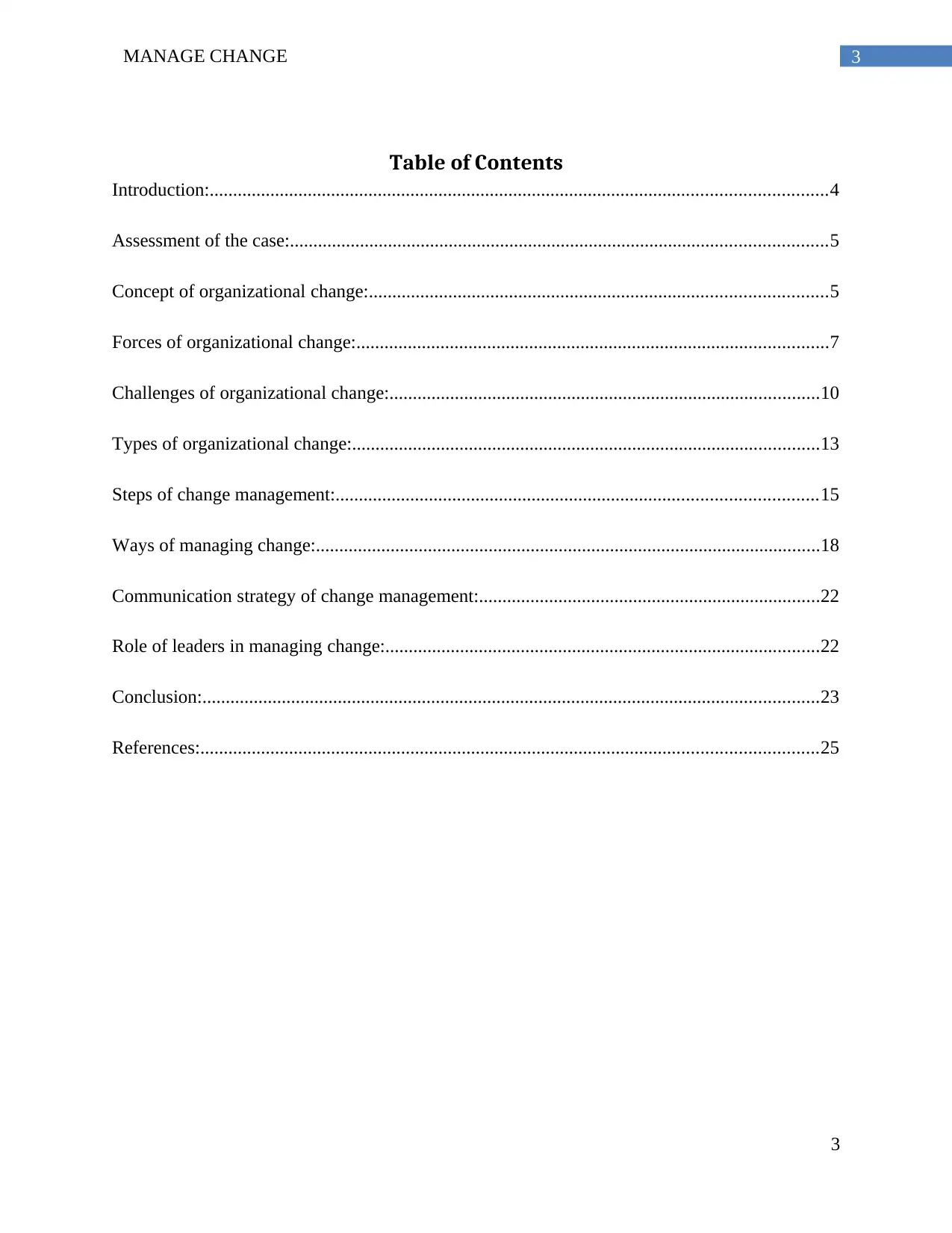
3MANAGE CHANGE
Table of Contents
Introduction:....................................................................................................................................4
Assessment of the case:...................................................................................................................5
Concept of organizational change:..................................................................................................5
Forces of organizational change:.....................................................................................................7
Challenges of organizational change:............................................................................................10
Types of organizational change:....................................................................................................13
Steps of change management:.......................................................................................................15
Ways of managing change:............................................................................................................18
Communication strategy of change management:.........................................................................22
Role of leaders in managing change:.............................................................................................22
Conclusion:....................................................................................................................................23
References:....................................................................................................................................25
3
Table of Contents
Introduction:....................................................................................................................................4
Assessment of the case:...................................................................................................................5
Concept of organizational change:..................................................................................................5
Forces of organizational change:.....................................................................................................7
Challenges of organizational change:............................................................................................10
Types of organizational change:....................................................................................................13
Steps of change management:.......................................................................................................15
Ways of managing change:............................................................................................................18
Communication strategy of change management:.........................................................................22
Role of leaders in managing change:.............................................................................................22
Conclusion:....................................................................................................................................23
References:....................................................................................................................................25
3
⊘ This is a preview!⊘
Do you want full access?
Subscribe today to unlock all pages.

Trusted by 1+ million students worldwide
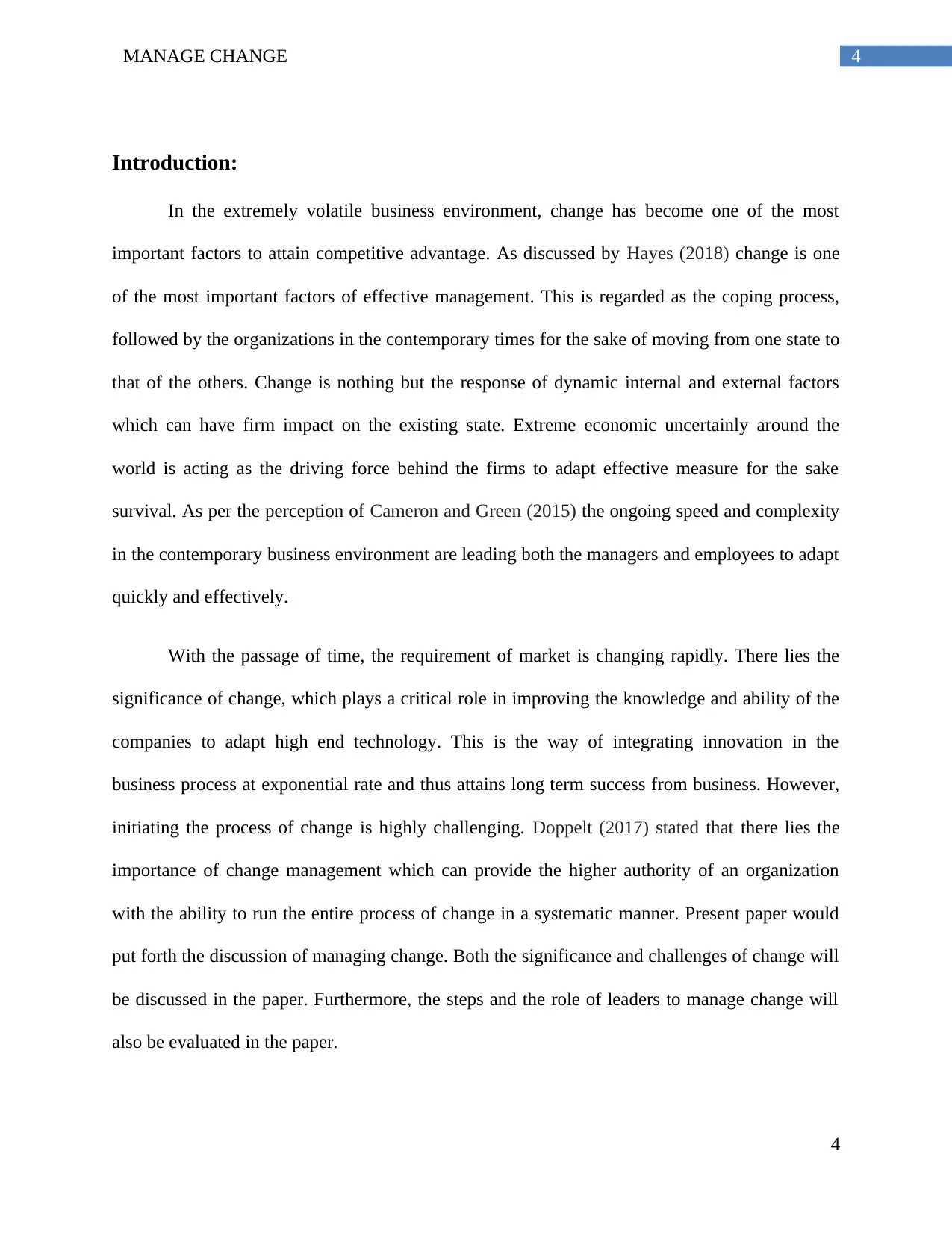
4MANAGE CHANGE
Introduction:
In the extremely volatile business environment, change has become one of the most
important factors to attain competitive advantage. As discussed by Hayes (2018) change is one
of the most important factors of effective management. This is regarded as the coping process,
followed by the organizations in the contemporary times for the sake of moving from one state to
that of the others. Change is nothing but the response of dynamic internal and external factors
which can have firm impact on the existing state. Extreme economic uncertainly around the
world is acting as the driving force behind the firms to adapt effective measure for the sake
survival. As per the perception of Cameron and Green (2015) the ongoing speed and complexity
in the contemporary business environment are leading both the managers and employees to adapt
quickly and effectively.
With the passage of time, the requirement of market is changing rapidly. There lies the
significance of change, which plays a critical role in improving the knowledge and ability of the
companies to adapt high end technology. This is the way of integrating innovation in the
business process at exponential rate and thus attains long term success from business. However,
initiating the process of change is highly challenging. Doppelt (2017) stated that there lies the
importance of change management which can provide the higher authority of an organization
with the ability to run the entire process of change in a systematic manner. Present paper would
put forth the discussion of managing change. Both the significance and challenges of change will
be discussed in the paper. Furthermore, the steps and the role of leaders to manage change will
also be evaluated in the paper.
4
Introduction:
In the extremely volatile business environment, change has become one of the most
important factors to attain competitive advantage. As discussed by Hayes (2018) change is one
of the most important factors of effective management. This is regarded as the coping process,
followed by the organizations in the contemporary times for the sake of moving from one state to
that of the others. Change is nothing but the response of dynamic internal and external factors
which can have firm impact on the existing state. Extreme economic uncertainly around the
world is acting as the driving force behind the firms to adapt effective measure for the sake
survival. As per the perception of Cameron and Green (2015) the ongoing speed and complexity
in the contemporary business environment are leading both the managers and employees to adapt
quickly and effectively.
With the passage of time, the requirement of market is changing rapidly. There lies the
significance of change, which plays a critical role in improving the knowledge and ability of the
companies to adapt high end technology. This is the way of integrating innovation in the
business process at exponential rate and thus attains long term success from business. However,
initiating the process of change is highly challenging. Doppelt (2017) stated that there lies the
importance of change management which can provide the higher authority of an organization
with the ability to run the entire process of change in a systematic manner. Present paper would
put forth the discussion of managing change. Both the significance and challenges of change will
be discussed in the paper. Furthermore, the steps and the role of leaders to manage change will
also be evaluated in the paper.
4
Paraphrase This Document
Need a fresh take? Get an instant paraphrase of this document with our AI Paraphraser
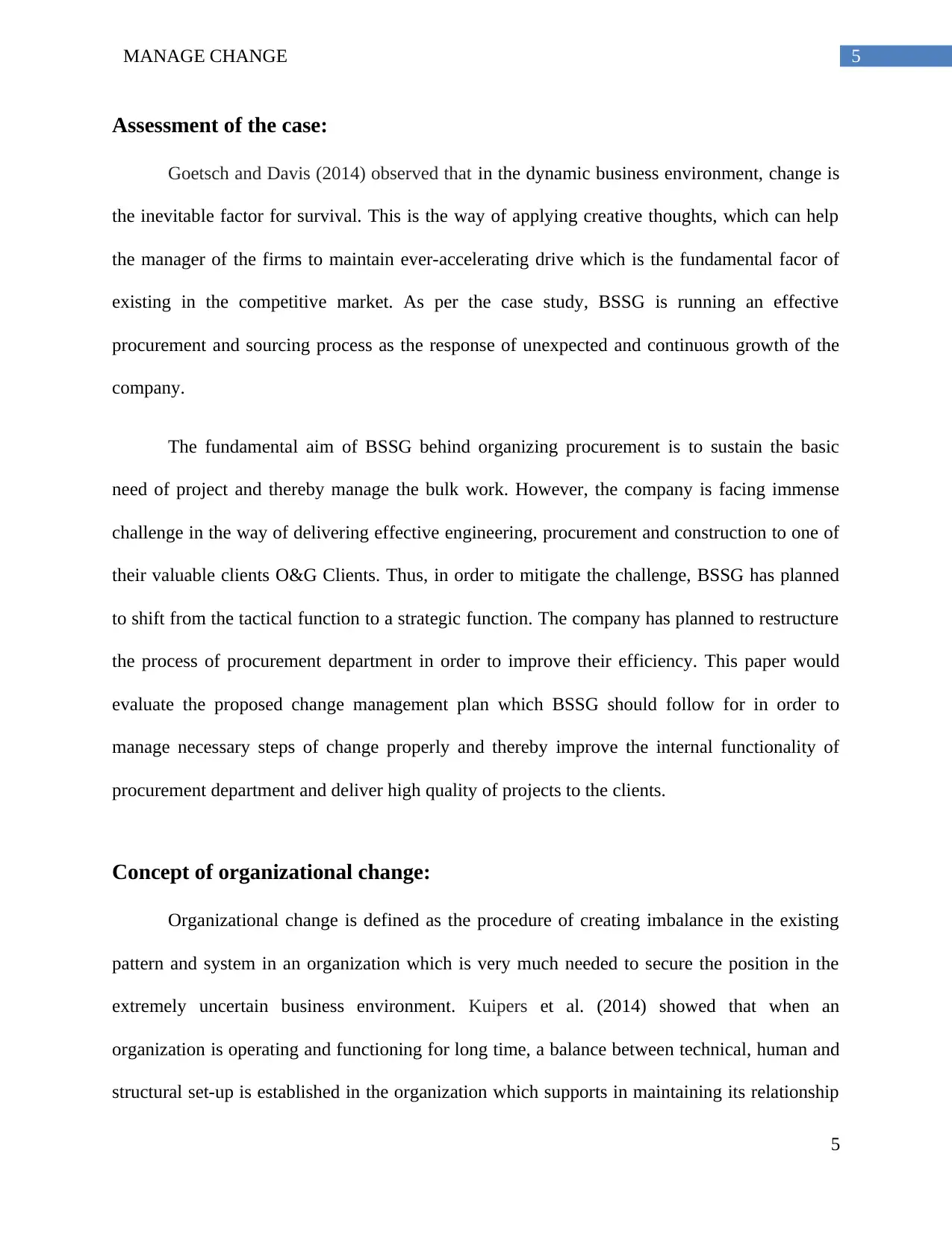
5MANAGE CHANGE
Assessment of the case:
Goetsch and Davis (2014) observed that in the dynamic business environment, change is
the inevitable factor for survival. This is the way of applying creative thoughts, which can help
the manager of the firms to maintain ever-accelerating drive which is the fundamental facor of
existing in the competitive market. As per the case study, BSSG is running an effective
procurement and sourcing process as the response of unexpected and continuous growth of the
company.
The fundamental aim of BSSG behind organizing procurement is to sustain the basic
need of project and thereby manage the bulk work. However, the company is facing immense
challenge in the way of delivering effective engineering, procurement and construction to one of
their valuable clients O&G Clients. Thus, in order to mitigate the challenge, BSSG has planned
to shift from the tactical function to a strategic function. The company has planned to restructure
the process of procurement department in order to improve their efficiency. This paper would
evaluate the proposed change management plan which BSSG should follow for in order to
manage necessary steps of change properly and thereby improve the internal functionality of
procurement department and deliver high quality of projects to the clients.
Concept of organizational change:
Organizational change is defined as the procedure of creating imbalance in the existing
pattern and system in an organization which is very much needed to secure the position in the
extremely uncertain business environment. Kuipers et al. (2014) showed that when an
organization is operating and functioning for long time, a balance between technical, human and
structural set-up is established in the organization which supports in maintaining its relationship
5
Assessment of the case:
Goetsch and Davis (2014) observed that in the dynamic business environment, change is
the inevitable factor for survival. This is the way of applying creative thoughts, which can help
the manager of the firms to maintain ever-accelerating drive which is the fundamental facor of
existing in the competitive market. As per the case study, BSSG is running an effective
procurement and sourcing process as the response of unexpected and continuous growth of the
company.
The fundamental aim of BSSG behind organizing procurement is to sustain the basic
need of project and thereby manage the bulk work. However, the company is facing immense
challenge in the way of delivering effective engineering, procurement and construction to one of
their valuable clients O&G Clients. Thus, in order to mitigate the challenge, BSSG has planned
to shift from the tactical function to a strategic function. The company has planned to restructure
the process of procurement department in order to improve their efficiency. This paper would
evaluate the proposed change management plan which BSSG should follow for in order to
manage necessary steps of change properly and thereby improve the internal functionality of
procurement department and deliver high quality of projects to the clients.
Concept of organizational change:
Organizational change is defined as the procedure of creating imbalance in the existing
pattern and system in an organization which is very much needed to secure the position in the
extremely uncertain business environment. Kuipers et al. (2014) showed that when an
organization is operating and functioning for long time, a balance between technical, human and
structural set-up is established in the organization which supports in maintaining its relationship
5
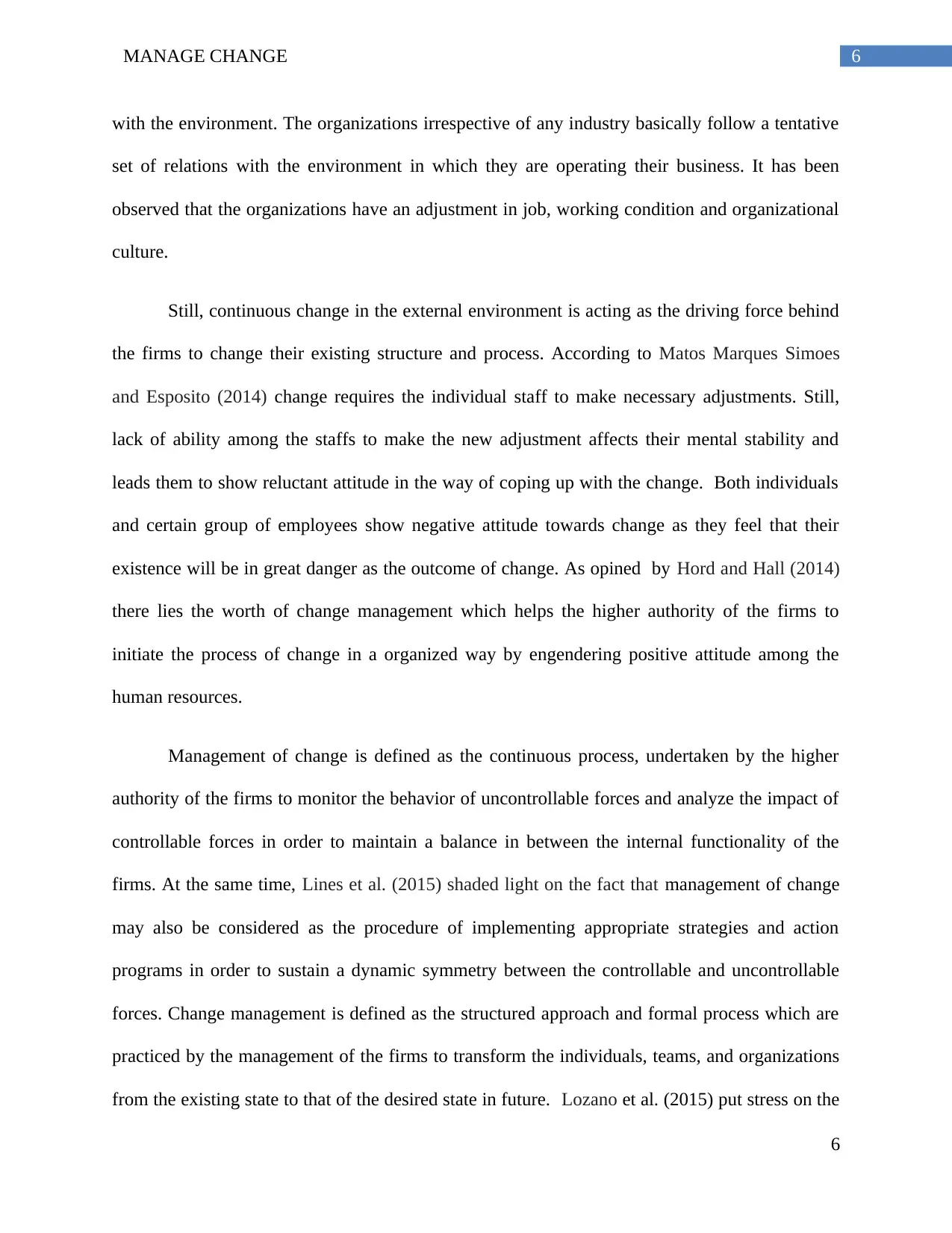
6MANAGE CHANGE
with the environment. The organizations irrespective of any industry basically follow a tentative
set of relations with the environment in which they are operating their business. It has been
observed that the organizations have an adjustment in job, working condition and organizational
culture.
Still, continuous change in the external environment is acting as the driving force behind
the firms to change their existing structure and process. According to Matos Marques Simoes
and Esposito (2014) change requires the individual staff to make necessary adjustments. Still,
lack of ability among the staffs to make the new adjustment affects their mental stability and
leads them to show reluctant attitude in the way of coping up with the change. Both individuals
and certain group of employees show negative attitude towards change as they feel that their
existence will be in great danger as the outcome of change. As opined by Hord and Hall (2014)
there lies the worth of change management which helps the higher authority of the firms to
initiate the process of change in a organized way by engendering positive attitude among the
human resources.
Management of change is defined as the continuous process, undertaken by the higher
authority of the firms to monitor the behavior of uncontrollable forces and analyze the impact of
controllable forces in order to maintain a balance in between the internal functionality of the
firms. At the same time, Lines et al. (2015) shaded light on the fact that management of change
may also be considered as the procedure of implementing appropriate strategies and action
programs in order to sustain a dynamic symmetry between the controllable and uncontrollable
forces. Change management is defined as the structured approach and formal process which are
practiced by the management of the firms to transform the individuals, teams, and organizations
from the existing state to that of the desired state in future. Lozano et al. (2015) put stress on the
6
with the environment. The organizations irrespective of any industry basically follow a tentative
set of relations with the environment in which they are operating their business. It has been
observed that the organizations have an adjustment in job, working condition and organizational
culture.
Still, continuous change in the external environment is acting as the driving force behind
the firms to change their existing structure and process. According to Matos Marques Simoes
and Esposito (2014) change requires the individual staff to make necessary adjustments. Still,
lack of ability among the staffs to make the new adjustment affects their mental stability and
leads them to show reluctant attitude in the way of coping up with the change. Both individuals
and certain group of employees show negative attitude towards change as they feel that their
existence will be in great danger as the outcome of change. As opined by Hord and Hall (2014)
there lies the worth of change management which helps the higher authority of the firms to
initiate the process of change in a organized way by engendering positive attitude among the
human resources.
Management of change is defined as the continuous process, undertaken by the higher
authority of the firms to monitor the behavior of uncontrollable forces and analyze the impact of
controllable forces in order to maintain a balance in between the internal functionality of the
firms. At the same time, Lines et al. (2015) shaded light on the fact that management of change
may also be considered as the procedure of implementing appropriate strategies and action
programs in order to sustain a dynamic symmetry between the controllable and uncontrollable
forces. Change management is defined as the structured approach and formal process which are
practiced by the management of the firms to transform the individuals, teams, and organizations
from the existing state to that of the desired state in future. Lozano et al. (2015) put stress on the
6
⊘ This is a preview!⊘
Do you want full access?
Subscribe today to unlock all pages.

Trusted by 1+ million students worldwide
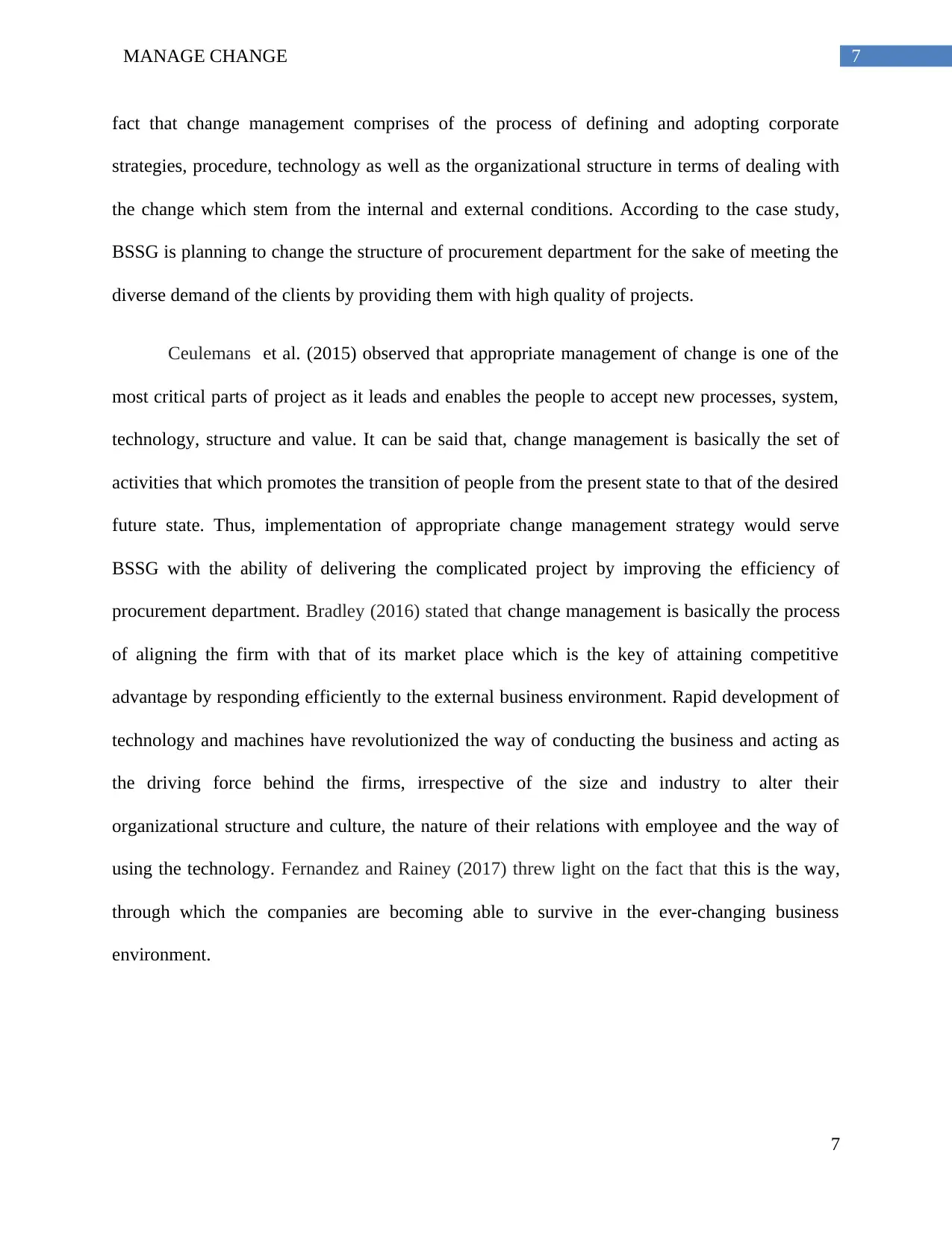
7MANAGE CHANGE
fact that change management comprises of the process of defining and adopting corporate
strategies, procedure, technology as well as the organizational structure in terms of dealing with
the change which stem from the internal and external conditions. According to the case study,
BSSG is planning to change the structure of procurement department for the sake of meeting the
diverse demand of the clients by providing them with high quality of projects.
Ceulemans et al. (2015) observed that appropriate management of change is one of the
most critical parts of project as it leads and enables the people to accept new processes, system,
technology, structure and value. It can be said that, change management is basically the set of
activities that which promotes the transition of people from the present state to that of the desired
future state. Thus, implementation of appropriate change management strategy would serve
BSSG with the ability of delivering the complicated project by improving the efficiency of
procurement department. Bradley (2016) stated that change management is basically the process
of aligning the firm with that of its market place which is the key of attaining competitive
advantage by responding efficiently to the external business environment. Rapid development of
technology and machines have revolutionized the way of conducting the business and acting as
the driving force behind the firms, irrespective of the size and industry to alter their
organizational structure and culture, the nature of their relations with employee and the way of
using the technology. Fernandez and Rainey (2017) threw light on the fact that this is the way,
through which the companies are becoming able to survive in the ever-changing business
environment.
7
fact that change management comprises of the process of defining and adopting corporate
strategies, procedure, technology as well as the organizational structure in terms of dealing with
the change which stem from the internal and external conditions. According to the case study,
BSSG is planning to change the structure of procurement department for the sake of meeting the
diverse demand of the clients by providing them with high quality of projects.
Ceulemans et al. (2015) observed that appropriate management of change is one of the
most critical parts of project as it leads and enables the people to accept new processes, system,
technology, structure and value. It can be said that, change management is basically the set of
activities that which promotes the transition of people from the present state to that of the desired
future state. Thus, implementation of appropriate change management strategy would serve
BSSG with the ability of delivering the complicated project by improving the efficiency of
procurement department. Bradley (2016) stated that change management is basically the process
of aligning the firm with that of its market place which is the key of attaining competitive
advantage by responding efficiently to the external business environment. Rapid development of
technology and machines have revolutionized the way of conducting the business and acting as
the driving force behind the firms, irrespective of the size and industry to alter their
organizational structure and culture, the nature of their relations with employee and the way of
using the technology. Fernandez and Rainey (2017) threw light on the fact that this is the way,
through which the companies are becoming able to survive in the ever-changing business
environment.
7
Paraphrase This Document
Need a fresh take? Get an instant paraphrase of this document with our AI Paraphraser
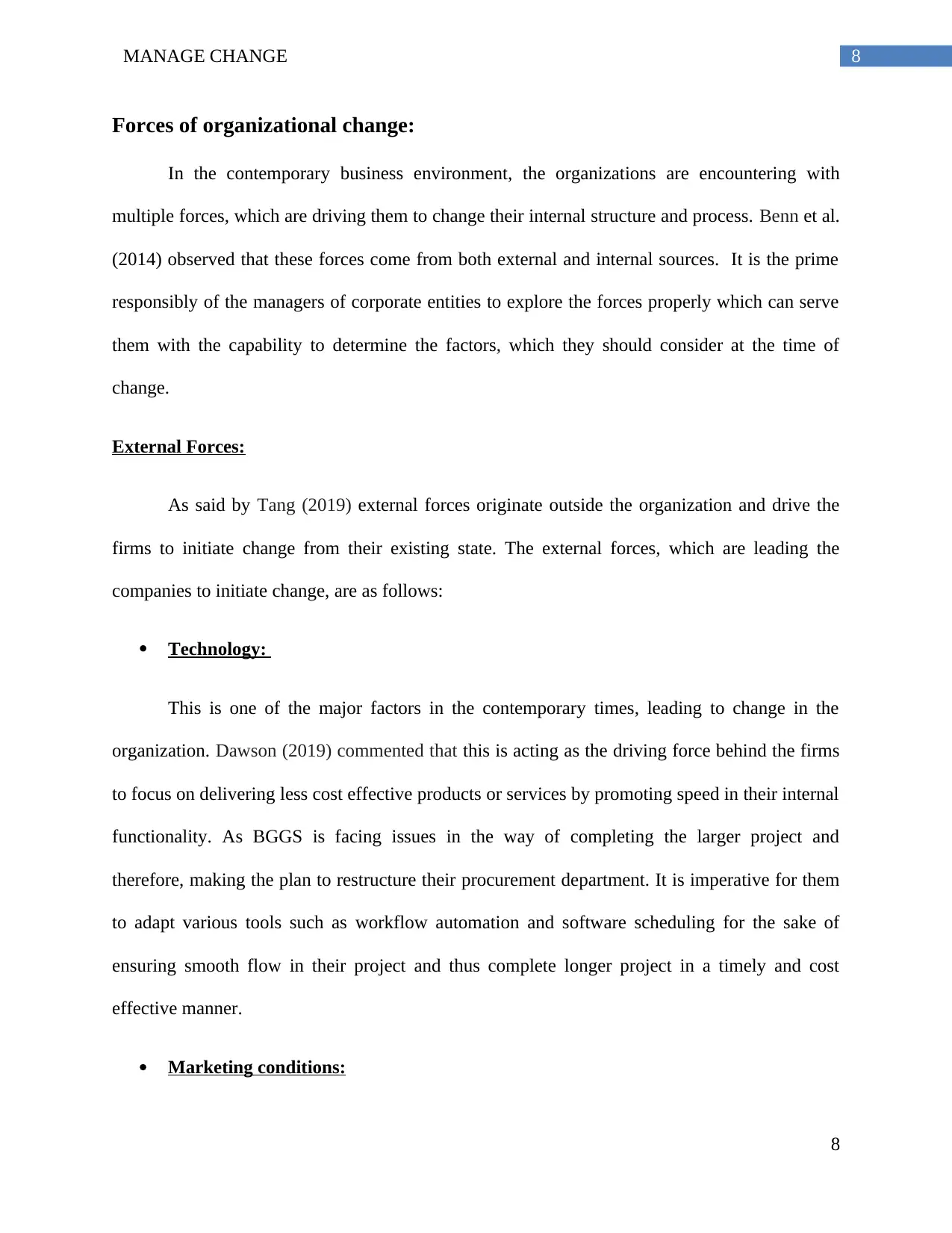
8MANAGE CHANGE
Forces of organizational change:
In the contemporary business environment, the organizations are encountering with
multiple forces, which are driving them to change their internal structure and process. Benn et al.
(2014) observed that these forces come from both external and internal sources. It is the prime
responsibly of the managers of corporate entities to explore the forces properly which can serve
them with the capability to determine the factors, which they should consider at the time of
change.
External Forces:
As said by Tang (2019) external forces originate outside the organization and drive the
firms to initiate change from their existing state. The external forces, which are leading the
companies to initiate change, are as follows:
Technology:
This is one of the major factors in the contemporary times, leading to change in the
organization. Dawson (2019) commented that this is acting as the driving force behind the firms
to focus on delivering less cost effective products or services by promoting speed in their internal
functionality. As BGGS is facing issues in the way of completing the larger project and
therefore, making the plan to restructure their procurement department. It is imperative for them
to adapt various tools such as workflow automation and software scheduling for the sake of
ensuring smooth flow in their project and thus complete longer project in a timely and cost
effective manner.
Marketing conditions:
8
Forces of organizational change:
In the contemporary business environment, the organizations are encountering with
multiple forces, which are driving them to change their internal structure and process. Benn et al.
(2014) observed that these forces come from both external and internal sources. It is the prime
responsibly of the managers of corporate entities to explore the forces properly which can serve
them with the capability to determine the factors, which they should consider at the time of
change.
External Forces:
As said by Tang (2019) external forces originate outside the organization and drive the
firms to initiate change from their existing state. The external forces, which are leading the
companies to initiate change, are as follows:
Technology:
This is one of the major factors in the contemporary times, leading to change in the
organization. Dawson (2019) commented that this is acting as the driving force behind the firms
to focus on delivering less cost effective products or services by promoting speed in their internal
functionality. As BGGS is facing issues in the way of completing the larger project and
therefore, making the plan to restructure their procurement department. It is imperative for them
to adapt various tools such as workflow automation and software scheduling for the sake of
ensuring smooth flow in their project and thus complete longer project in a timely and cost
effective manner.
Marketing conditions:
8
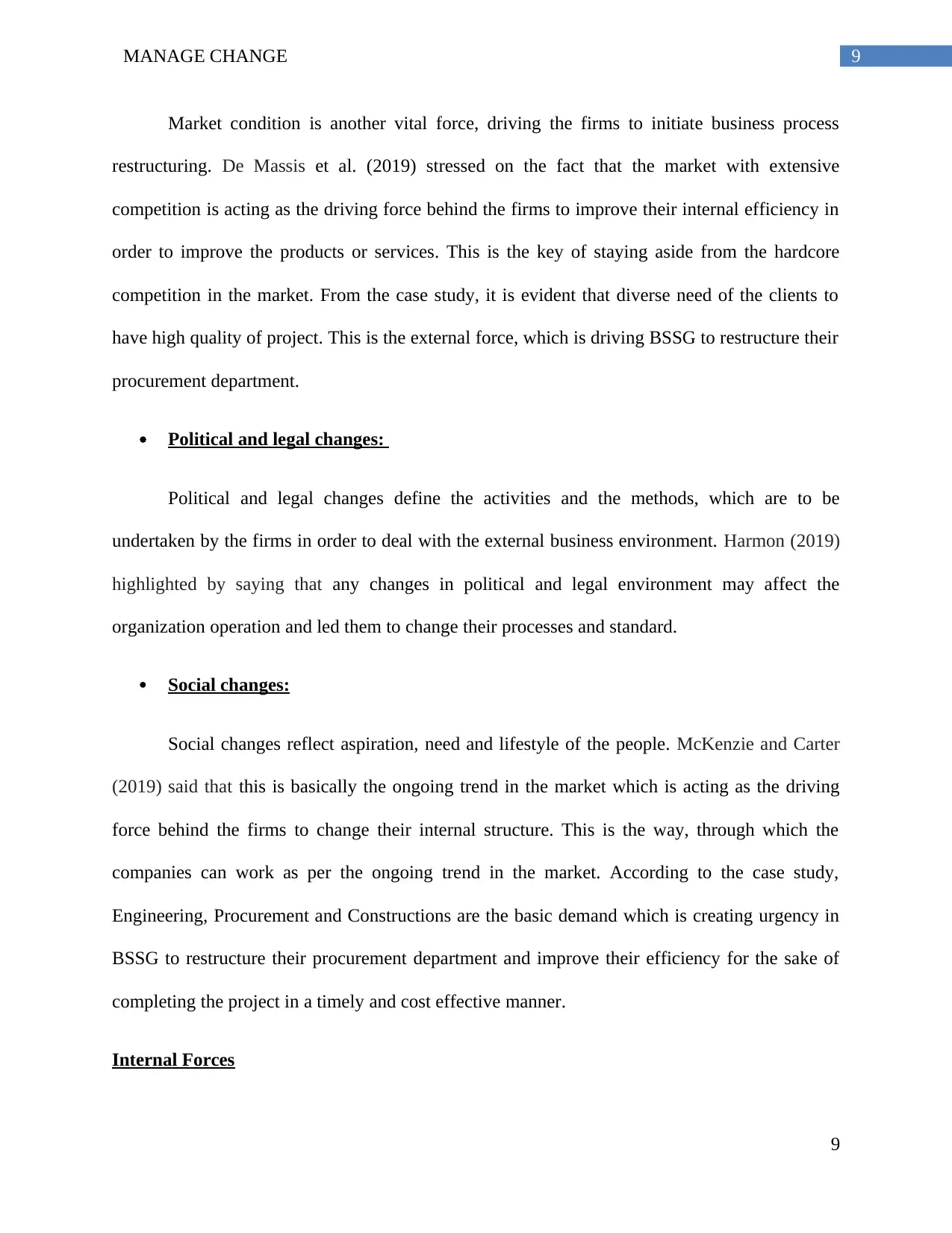
9MANAGE CHANGE
Market condition is another vital force, driving the firms to initiate business process
restructuring. De Massis et al. (2019) stressed on the fact that the market with extensive
competition is acting as the driving force behind the firms to improve their internal efficiency in
order to improve the products or services. This is the key of staying aside from the hardcore
competition in the market. From the case study, it is evident that diverse need of the clients to
have high quality of project. This is the external force, which is driving BSSG to restructure their
procurement department.
Political and legal changes:
Political and legal changes define the activities and the methods, which are to be
undertaken by the firms in order to deal with the external business environment. Harmon (2019)
highlighted by saying that any changes in political and legal environment may affect the
organization operation and led them to change their processes and standard.
Social changes:
Social changes reflect aspiration, need and lifestyle of the people. McKenzie and Carter
(2019) said that this is basically the ongoing trend in the market which is acting as the driving
force behind the firms to change their internal structure. This is the way, through which the
companies can work as per the ongoing trend in the market. According to the case study,
Engineering, Procurement and Constructions are the basic demand which is creating urgency in
BSSG to restructure their procurement department and improve their efficiency for the sake of
completing the project in a timely and cost effective manner.
Internal Forces
9
Market condition is another vital force, driving the firms to initiate business process
restructuring. De Massis et al. (2019) stressed on the fact that the market with extensive
competition is acting as the driving force behind the firms to improve their internal efficiency in
order to improve the products or services. This is the key of staying aside from the hardcore
competition in the market. From the case study, it is evident that diverse need of the clients to
have high quality of project. This is the external force, which is driving BSSG to restructure their
procurement department.
Political and legal changes:
Political and legal changes define the activities and the methods, which are to be
undertaken by the firms in order to deal with the external business environment. Harmon (2019)
highlighted by saying that any changes in political and legal environment may affect the
organization operation and led them to change their processes and standard.
Social changes:
Social changes reflect aspiration, need and lifestyle of the people. McKenzie and Carter
(2019) said that this is basically the ongoing trend in the market which is acting as the driving
force behind the firms to change their internal structure. This is the way, through which the
companies can work as per the ongoing trend in the market. According to the case study,
Engineering, Procurement and Constructions are the basic demand which is creating urgency in
BSSG to restructure their procurement department and improve their efficiency for the sake of
completing the project in a timely and cost effective manner.
Internal Forces
9
⊘ This is a preview!⊘
Do you want full access?
Subscribe today to unlock all pages.

Trusted by 1+ million students worldwide
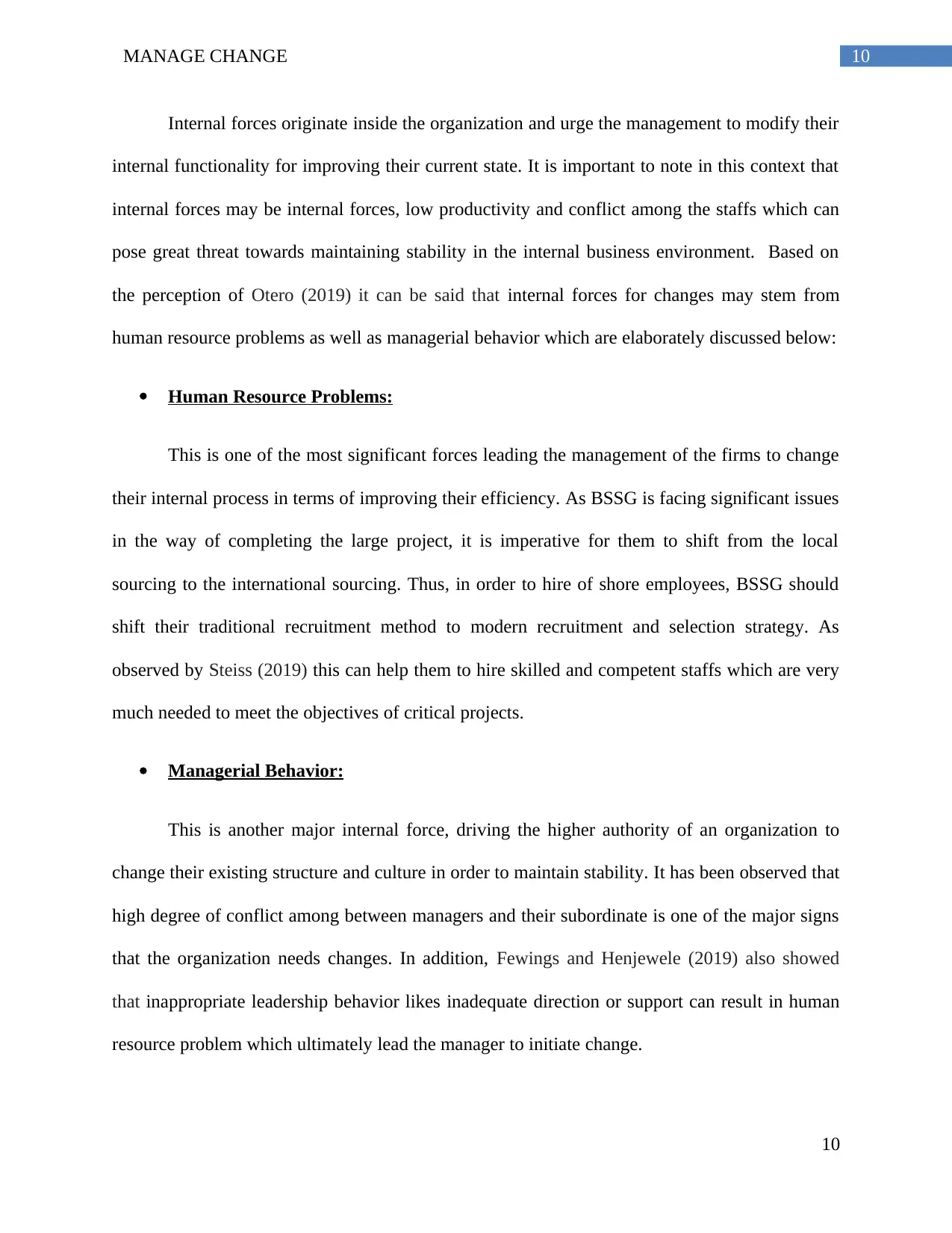
10MANAGE CHANGE
Internal forces originate inside the organization and urge the management to modify their
internal functionality for improving their current state. It is important to note in this context that
internal forces may be internal forces, low productivity and conflict among the staffs which can
pose great threat towards maintaining stability in the internal business environment. Based on
the perception of Otero (2019) it can be said that internal forces for changes may stem from
human resource problems as well as managerial behavior which are elaborately discussed below:
Human Resource Problems:
This is one of the most significant forces leading the management of the firms to change
their internal process in terms of improving their efficiency. As BSSG is facing significant issues
in the way of completing the large project, it is imperative for them to shift from the local
sourcing to the international sourcing. Thus, in order to hire of shore employees, BSSG should
shift their traditional recruitment method to modern recruitment and selection strategy. As
observed by Steiss (2019) this can help them to hire skilled and competent staffs which are very
much needed to meet the objectives of critical projects.
Managerial Behavior:
This is another major internal force, driving the higher authority of an organization to
change their existing structure and culture in order to maintain stability. It has been observed that
high degree of conflict among between managers and their subordinate is one of the major signs
that the organization needs changes. In addition, Fewings and Henjewele (2019) also showed
that inappropriate leadership behavior likes inadequate direction or support can result in human
resource problem which ultimately lead the manager to initiate change.
10
Internal forces originate inside the organization and urge the management to modify their
internal functionality for improving their current state. It is important to note in this context that
internal forces may be internal forces, low productivity and conflict among the staffs which can
pose great threat towards maintaining stability in the internal business environment. Based on
the perception of Otero (2019) it can be said that internal forces for changes may stem from
human resource problems as well as managerial behavior which are elaborately discussed below:
Human Resource Problems:
This is one of the most significant forces leading the management of the firms to change
their internal process in terms of improving their efficiency. As BSSG is facing significant issues
in the way of completing the large project, it is imperative for them to shift from the local
sourcing to the international sourcing. Thus, in order to hire of shore employees, BSSG should
shift their traditional recruitment method to modern recruitment and selection strategy. As
observed by Steiss (2019) this can help them to hire skilled and competent staffs which are very
much needed to meet the objectives of critical projects.
Managerial Behavior:
This is another major internal force, driving the higher authority of an organization to
change their existing structure and culture in order to maintain stability. It has been observed that
high degree of conflict among between managers and their subordinate is one of the major signs
that the organization needs changes. In addition, Fewings and Henjewele (2019) also showed
that inappropriate leadership behavior likes inadequate direction or support can result in human
resource problem which ultimately lead the manager to initiate change.
10
Paraphrase This Document
Need a fresh take? Get an instant paraphrase of this document with our AI Paraphraser
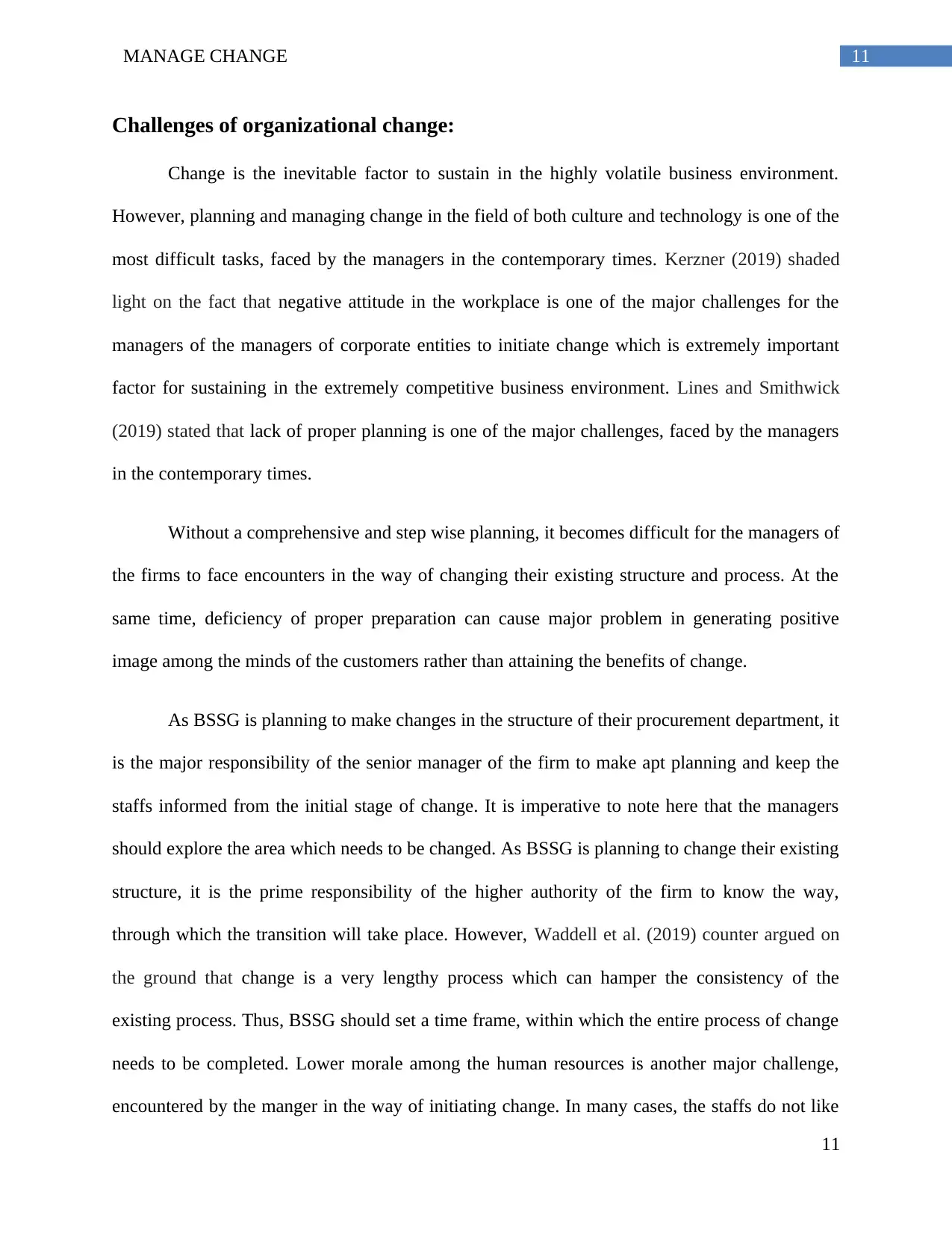
11MANAGE CHANGE
Challenges of organizational change:
Change is the inevitable factor to sustain in the highly volatile business environment.
However, planning and managing change in the field of both culture and technology is one of the
most difficult tasks, faced by the managers in the contemporary times. Kerzner (2019) shaded
light on the fact that negative attitude in the workplace is one of the major challenges for the
managers of the managers of corporate entities to initiate change which is extremely important
factor for sustaining in the extremely competitive business environment. Lines and Smithwick
(2019) stated that lack of proper planning is one of the major challenges, faced by the managers
in the contemporary times.
Without a comprehensive and step wise planning, it becomes difficult for the managers of
the firms to face encounters in the way of changing their existing structure and process. At the
same time, deficiency of proper preparation can cause major problem in generating positive
image among the minds of the customers rather than attaining the benefits of change.
As BSSG is planning to make changes in the structure of their procurement department, it
is the major responsibility of the senior manager of the firm to make apt planning and keep the
staffs informed from the initial stage of change. It is imperative to note here that the managers
should explore the area which needs to be changed. As BSSG is planning to change their existing
structure, it is the prime responsibility of the higher authority of the firm to know the way,
through which the transition will take place. However, Waddell et al. (2019) counter argued on
the ground that change is a very lengthy process which can hamper the consistency of the
existing process. Thus, BSSG should set a time frame, within which the entire process of change
needs to be completed. Lower morale among the human resources is another major challenge,
encountered by the manger in the way of initiating change. In many cases, the staffs do not like
11
Challenges of organizational change:
Change is the inevitable factor to sustain in the highly volatile business environment.
However, planning and managing change in the field of both culture and technology is one of the
most difficult tasks, faced by the managers in the contemporary times. Kerzner (2019) shaded
light on the fact that negative attitude in the workplace is one of the major challenges for the
managers of the managers of corporate entities to initiate change which is extremely important
factor for sustaining in the extremely competitive business environment. Lines and Smithwick
(2019) stated that lack of proper planning is one of the major challenges, faced by the managers
in the contemporary times.
Without a comprehensive and step wise planning, it becomes difficult for the managers of
the firms to face encounters in the way of changing their existing structure and process. At the
same time, deficiency of proper preparation can cause major problem in generating positive
image among the minds of the customers rather than attaining the benefits of change.
As BSSG is planning to make changes in the structure of their procurement department, it
is the major responsibility of the senior manager of the firm to make apt planning and keep the
staffs informed from the initial stage of change. It is imperative to note here that the managers
should explore the area which needs to be changed. As BSSG is planning to change their existing
structure, it is the prime responsibility of the higher authority of the firm to know the way,
through which the transition will take place. However, Waddell et al. (2019) counter argued on
the ground that change is a very lengthy process which can hamper the consistency of the
existing process. Thus, BSSG should set a time frame, within which the entire process of change
needs to be completed. Lower morale among the human resources is another major challenge,
encountered by the manger in the way of initiating change. In many cases, the staffs do not like
11
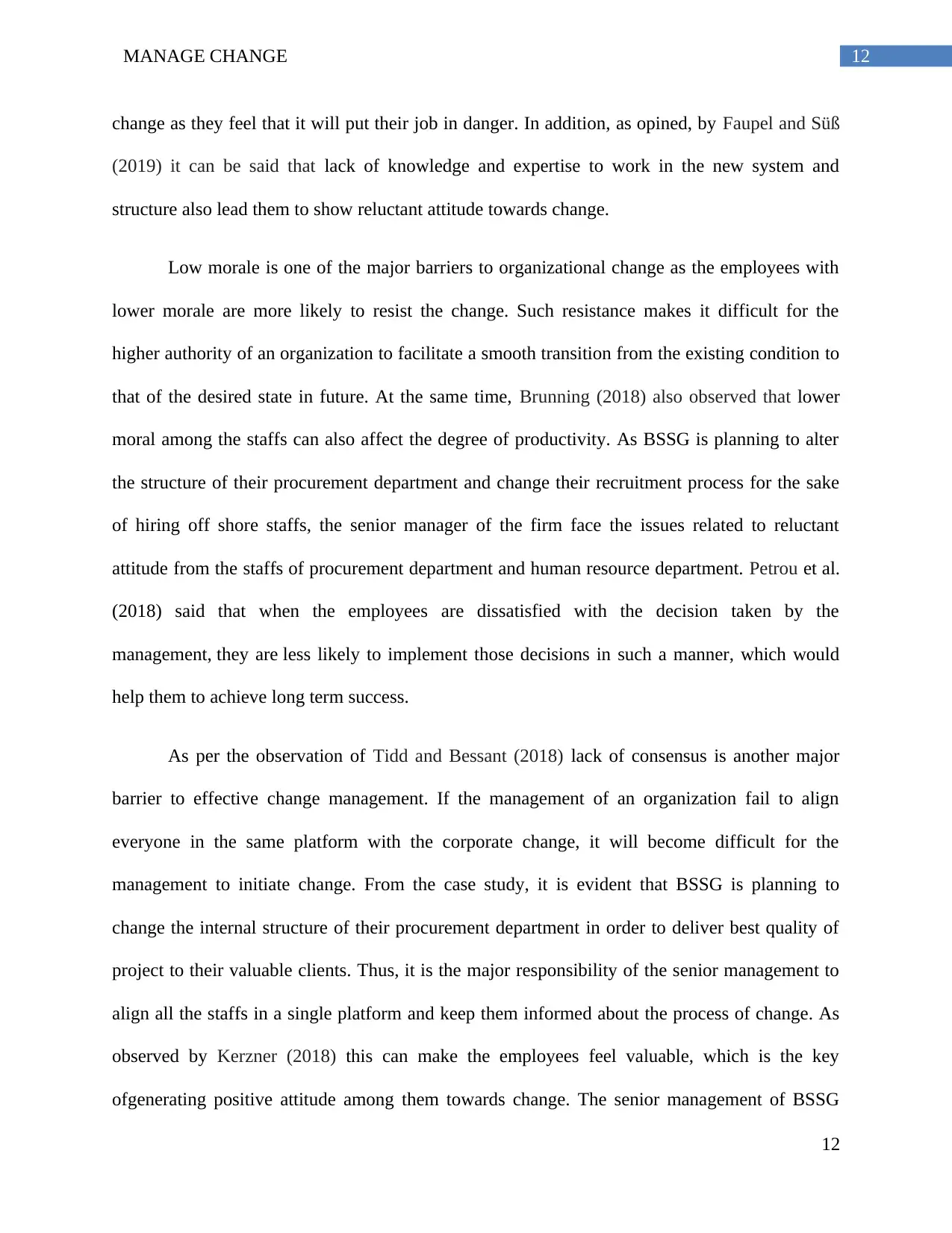
12MANAGE CHANGE
change as they feel that it will put their job in danger. In addition, as opined, by Faupel and Süß
(2019) it can be said that lack of knowledge and expertise to work in the new system and
structure also lead them to show reluctant attitude towards change.
Low morale is one of the major barriers to organizational change as the employees with
lower morale are more likely to resist the change. Such resistance makes it difficult for the
higher authority of an organization to facilitate a smooth transition from the existing condition to
that of the desired state in future. At the same time, Brunning (2018) also observed that lower
moral among the staffs can also affect the degree of productivity. As BSSG is planning to alter
the structure of their procurement department and change their recruitment process for the sake
of hiring off shore staffs, the senior manager of the firm face the issues related to reluctant
attitude from the staffs of procurement department and human resource department. Petrou et al.
(2018) said that when the employees are dissatisfied with the decision taken by the
management, they are less likely to implement those decisions in such a manner, which would
help them to achieve long term success.
As per the observation of Tidd and Bessant (2018) lack of consensus is another major
barrier to effective change management. If the management of an organization fail to align
everyone in the same platform with the corporate change, it will become difficult for the
management to initiate change. From the case study, it is evident that BSSG is planning to
change the internal structure of their procurement department in order to deliver best quality of
project to their valuable clients. Thus, it is the major responsibility of the senior management to
align all the staffs in a single platform and keep them informed about the process of change. As
observed by Kerzner (2018) this can make the employees feel valuable, which is the key
ofgenerating positive attitude among them towards change. The senior management of BSSG
12
change as they feel that it will put their job in danger. In addition, as opined, by Faupel and Süß
(2019) it can be said that lack of knowledge and expertise to work in the new system and
structure also lead them to show reluctant attitude towards change.
Low morale is one of the major barriers to organizational change as the employees with
lower morale are more likely to resist the change. Such resistance makes it difficult for the
higher authority of an organization to facilitate a smooth transition from the existing condition to
that of the desired state in future. At the same time, Brunning (2018) also observed that lower
moral among the staffs can also affect the degree of productivity. As BSSG is planning to alter
the structure of their procurement department and change their recruitment process for the sake
of hiring off shore staffs, the senior manager of the firm face the issues related to reluctant
attitude from the staffs of procurement department and human resource department. Petrou et al.
(2018) said that when the employees are dissatisfied with the decision taken by the
management, they are less likely to implement those decisions in such a manner, which would
help them to achieve long term success.
As per the observation of Tidd and Bessant (2018) lack of consensus is another major
barrier to effective change management. If the management of an organization fail to align
everyone in the same platform with the corporate change, it will become difficult for the
management to initiate change. From the case study, it is evident that BSSG is planning to
change the internal structure of their procurement department in order to deliver best quality of
project to their valuable clients. Thus, it is the major responsibility of the senior management to
align all the staffs in a single platform and keep them informed about the process of change. As
observed by Kerzner (2018) this can make the employees feel valuable, which is the key
ofgenerating positive attitude among them towards change. The senior management of BSSG
12
⊘ This is a preview!⊘
Do you want full access?
Subscribe today to unlock all pages.

Trusted by 1+ million students worldwide
1 out of 29
Related Documents
Your All-in-One AI-Powered Toolkit for Academic Success.
+13062052269
info@desklib.com
Available 24*7 on WhatsApp / Email
![[object Object]](/_next/static/media/star-bottom.7253800d.svg)
Unlock your academic potential
Copyright © 2020–2025 A2Z Services. All Rights Reserved. Developed and managed by ZUCOL.





